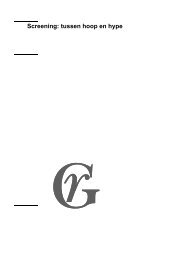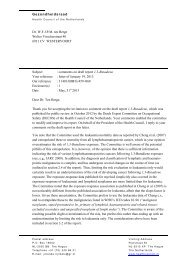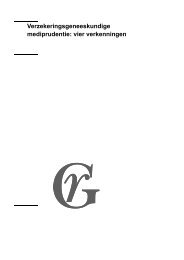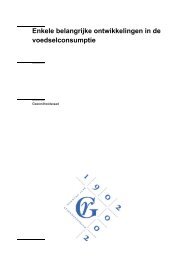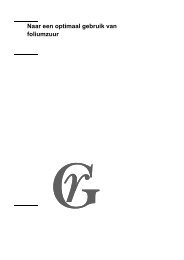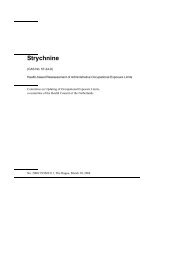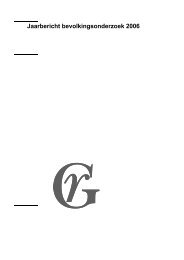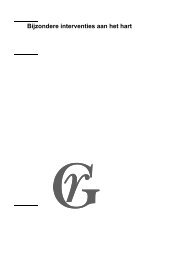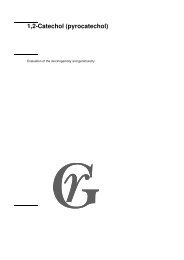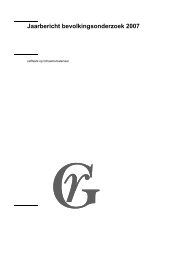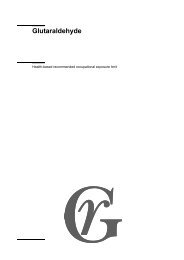Liquefied petroleum gas (LPG) - Gezondheidsraad
Liquefied petroleum gas (LPG) - Gezondheidsraad
Liquefied petroleum gas (LPG) - Gezondheidsraad
Create successful ePaper yourself
Turn your PDF publications into a flip-book with our unique Google optimized e-Paper software.
espectively. Slight anaesthesia was observed at exposure to 130,000 or 220,000<br />
ppm (314,600 and 532,400 mg/m 3 ) for 25 and 1 minute, respectively, while 15-<br />
minute exposure to the higher concentration induced complete anaesthesia<br />
(Ber95b, Low87b). In dogs, concentrations of 200,000-250,000 ppm (484,000-<br />
605,000 mg/m 3 ) caused anaesthesia and mortality within a few minutes. Other<br />
studies showed butane to sensitise the heart to epinephrine-induced cardiac<br />
arrhythmias or ventricular fibrillation at levels of 150,000-900,000 (363,000-<br />
2,178,000 mg/m 3 ), for 10 minutes, and of 10,000-200,000 ppm (24,200-484,000<br />
mg/m 3 ), for 2 minutes to 2 hours, respectively (Ber95b, Low87b), while<br />
exposure to 5000 ppm (12,100 mg/m 3 ) had caused haemodynamic changes in<br />
anaesthetised dogs, such as a decrease in cardiac output, left ventricular pressure,<br />
and stroke volume, a decrease in myocardial contractility, and aortic pressure<br />
(Low87b).<br />
Halder et al. examined the toxicity of a hydrocarbon blend vapour consisting<br />
of 25% (w/w) each of butane, pentane, isobutane, and isopentane by exposing<br />
rats (Sprague-Dawley; n=10/sex/group) to, analytical, time-weighted average,<br />
total hydrocarbon concentrations of 0, 116, 1150, or 11,800 mg/m 3<br />
(0, 44, 432, and 4437 ppm). Particular attention was paid to effects on the<br />
kidneys. Histological examinations were also done on the brain, heart, liver,<br />
spleen, adrenals, and gonads. During exposure, no clinical signs of toxicity were<br />
observed. Post-mortem examinations did not show macroscopic or microscopic<br />
changes in any of the organs examined in any of the treated groups and no<br />
evidence of the presence of the male-rat-specific, hydrocarbon-induced<br />
nephropathy (Hal86). From this study, the committee concluded that the NOAEL<br />
for rats is at least 11,800 mg/m 3 for total hydrocarbons and at least 2950 mg/m 3<br />
(1210 ppm) for butane.<br />
The same research group exposed 20 male and 10 female rats (Fischer 344)<br />
to analytical, time-weighted average, concentrations of a mixture of butane and<br />
pentane of 1017 and 4489 ppm, for 13 weeks. The relative proportions of butane<br />
in the mixture were 51.5 and 47.5 wt%, respectively. A control group consisting<br />
of 40 male and 20 female animals was included. At day 28, necropsies were<br />
performed for half of the male rats of each treatment group. All animals survived<br />
exposure. Aranyi et al. reported possible treatment-related, but not dose-related,<br />
signs of toxicity including transient hunched posture and/or lethargy and<br />
intermittent tremor and statistically significantly decreased body weights for<br />
both males and females by test week 3 and 4. At the end of the study, body<br />
weights were comparable to those of controls. At post-mortem examinations,<br />
liver and kidney weights were not affected and no gross, treatment-related<br />
lesions were observed. Only the kidneys were examined microscopically and<br />
134-12 Health-based Reassessment of Administrative Occupational Exposure Limits



